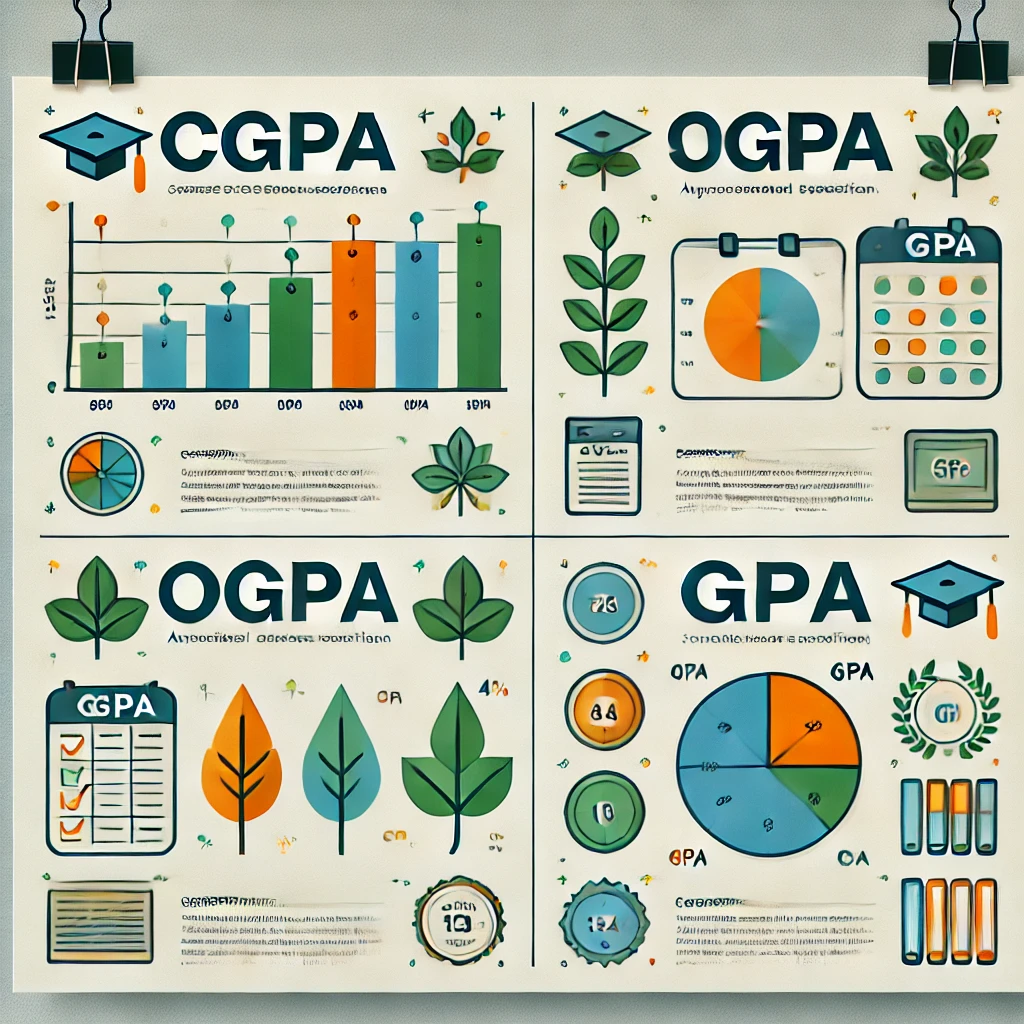How well you do in school plays a big role in shaping your future. No matter if you’re in high school, college, or university, you’ve seen or used different ways to grade students.
You might have heard terms like CGPA Percentage OGPA, SGPA, and GPA thrown around a lot. But many students (and even some pros who sometimes work in this field) often mix these up.
This Blog will explain what CGPA, OGPA, SGPA, and GPA mean why these short forms matter, and how each one helps you on your school journey.

What is GPA?
GPA short for Grade Point Average, is the grading system that most schools use across the globe, with the US leading the pack. It shows how well a student does in all their classes during a term or school year. To figure out GPA, you divide the total points you’ve earned by the number of credits you’ve taken.
Here’s how you work it out:
GPA = (Total Grade Points Earned) / (Total Credit Hours Taken)
Types Of GPA:
Cumulative GPA: This is your overall score from all your terms or years at school.
Semester GPA: This looks at your grades from one term and doesn’t count your other semesters.
Importance of GPA:
GPA measures a student’s academic abilities and is often considered in scholarship opportunities, internships, graduate school applications, and even job interviews. A higher GPA often correlates with better academic performance, while a lower GPA could indicate a student struggling academically.
What is SGPA?
SGPA, or Semester Grade Point Average, measures academic performance in a single semester. It includes only the grades from the courses taken that semester and gives students a snapshot of their performance.Formula:SGPA = (Sum of (Course Credits × Grade Points)) / (Total Credits of All Courses in a Semester)
Importance of SGPA:
SGPA provides immediate feedback on how a student is progressing within a semester. Unlike GPA, which may consider cumulative performance, SGPA focuses on one specific term, allowing students to track their academic standing regularly. Many universities use SGPA to determine if students qualify for honors, probation, or other academic statuses.
What is CGPA?
CGPA, or Cumulative Grade Point Average, reflects the overall academic performance across multiple semesters or academic years. The average of all SGPA scores provides a comprehensive picture of a student’s academic achievements over time.
Formula:
CGPA = (Total Grade Points Earned Across All Semesters) / (Total Credits Attempted Across All Semesters)
Importance of CGPA:
CGPA plays a critical role when applying for higher education, especially in international universities, as it shows consistent performance over a longer period. Many institutions and employers use CGPA to assess a candidate’s academic competence and potential.
CGPA vs. GPA:
The main difference between CGPA and GPA is that GPA typically reflects performance over a shorter period (like a semester), while CGPA reflects performance over the entire academic program. Both are essential, but CGPA provides a more comprehensive view of a student’s academic journey.
What is OGPA?
OGPA, or Overall Grade Point Average, is similar to CGPA in many ways. It encompasses a student’s overall performance but is mainly used in some countries’ agricultural universities or technical institutions. OGPA is also calculated similarly to CGPA but may follow a different grading scale depending on the institution.
Formula:
OGPA = (Sum of (Grade Points × Credit Hours Earned Over All Semesters)) / (Total Credit Hours Attempted Over All Semesters)
OGPA vs. CGPA:
OGPA and CGPA are often used interchangeably, but their usage depends on the institution. While CGPA is a more universal term, OGPA is typically specific to certain educational systems or universities. The calculation methods are nearly identical, but some institutions may apply slight variations.
How do you calculate CGPA, OGPA, SGPA, and GPA?

Steps to Calculate SGPA:
- List out all the courses taken in the semester.
- Assign the grade points corresponding to the marks/grades obtained.
- Multiply each course’s grade points by the number of credits for that course.
- Add the total grade points for all courses.
- Divide the sum by the total number of credits attempted in the semester.
Steps to Calculate CGPA or OGPA:
- Collect the SGPAs from each semester.
- Multiply each SGPA by the total credits of that semester.
- Add the total grade points from all semesters.
- Divide the result by the total number of credits across all semesters.
Steps to Calculate GPA:
- Multiply the grade points by the course credit hours.
- Add the grade points for all courses.
- Divide by the total number of credit hours attempted.
CGPA vs. OGPA vs. SGPA vs. GPA: Key Differences
- Scope: GPA is specific to a single term, SGPA is also term-specific but focused on a single semester, CGPA represents cumulative performance across multiple semesters, and OGPA generally represents the same as CGPA but may be used differently in various systems.
- Timeframe: GPA and SGPA cover short periods (e.g., one semester), while CGPA and OGPA cover longer durations (e.g., entire academic programs).
- Calculation Basis: GPA and SGPA calculations are based on individual term performance, while CGPA and OGPA consider cumulative performance over time.
Why Are These Metrics Important?
These grading systems help students understand their academic progress and allow educators to track student performance efficiently. The significance of CGPA, OGPA, SGPA, and GPA extends beyond just grades;
they are often used for:
Academic Status: Institutions use these scores to grant honors or scholarships, or determine if a student is on probation.
Job Applications: Employers may use these scores to evaluate candidates.
Graduate School Applications: Higher education institutions, especially internationally, often consider CGPA an essential admission criterion.
Self-Evaluation: Students can use these metrics to measure their progress and set goals for future improvement.
The Final Verdict:
Therefore, it is of utmost importance for students to comprehend the differences between the four types of Point Average systems: CGPA vs OGPA vs SGPA vs GPA. This understanding is key to tracking your academic achievements and future career opportunities.
Whether you’re aiming for college, university, scholarships, or jobs, this knowledge is crucial for making informed decisions. Each system offers a unique perspective on your academic journey, providing immediate feedback in the form of SGPA, GPA, or a comprehensive overview through CGPA, OGPA.
That way, when you receive your grades, you will understand what your SGPA, CGPA, GPA, or OGPA means and its impact on your academic and career path.
FAQS:
Are OGPA and CGPA the Same?
No, OGPA and CGPA are not the same, though they are similar. OGPA refers to the overall grade point average, which is primarily used in certain technical or agricultural universities. On the other hand, CGPA stands for Cumulative Grade Point Average, which is widely accepted and used in most educational institutions globally. The formulas for calculating both are quite similar, but OGPA is specific to particular academic fields or institutions.
What is GPA vs. SGPA vs. CGPA?
GPA, SGPA, and CGPA are all measures of academic performance, but they apply to different contexts. GPA is a more general term used to calculate grades over a specific period, such as a semester or year.
SGPA is more specific and only represents the performance in a single semester. CGPA, on the other hand, is the cumulative performance across multiple semesters, representing a student’s overall academic progress throughout their course.
Is OGPA and Percentage the Same?
No, OGPA and percentage are different, though they can sometimes be converted into each other. OGPA is a grade point system, while percentage refers to marks obtained out of 100. To convert OGPA to percentage, you may need to follow your institution’s specific conversion formula, which may vary. In many cases, multiplying OGPA by 9.5 gives a rough equivalent in percentage, but this can differ depending on your institution’s grading scale.





